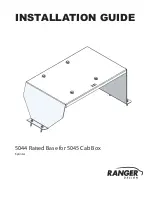
8.9
IntAGain
This value determines how rapidly the over-ride output will ramp down
when the current from the battery pack exceeds the programmed
current limit. Too low of a value will result in considerable overshooting
of the set point current, while too large of a gain will cause the
controller to oscillate above and below the limit. The range of
allowable values is from 0 to 999.
8.10
IntVGain
Default = 800
This value determines how rapidly the over-ride output signal will
scale down when the pack voltage falls below the set low voltage
cutout. The range of allowable values is from 0 to 999, and the scaling
is arbitrary.
8.11
ITermMax
Default = 3.79V
This puts an upper limit on how high the throttle over-ride will drift
upwards when none of the limit values are being exceeded. Ideally this
value is set to the voltage that is considered full throttle by the
controller. For hall effect throttles, full power occurs at about 4V, and
limiting the ITerm to this value will speed up the response time of the
limiting features. Allowable values are from 0 to 4.99V.
8.12
ITermMin
Default = 0.0V
This value imposes a lower bound on how low the throttle over-ride
can drift downwards when one of the limiting values is being
exceeded. By preventing the over-ride signal from going all the way to
0V, you can decrease the recovery time for the signal to go back
upwards. Range is from 0 to 4.99V, and must be less than ItermMax.
8.13
Max Throttle
Default = 4.99V
This value puts a maximum cap on the throttle output signal. It can be
used to simulate a lower speed motor by simply clamping the throttle
signal to a value between 0 to 5V. Be aware that the majority of hall
effect throttles only operate from 1V to 4V, and so the desired setting to
reduce the speed would fall in this range (less the diode voltage drop).
Default = 300
16







































